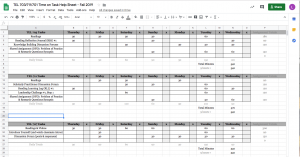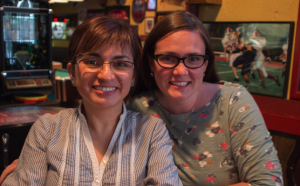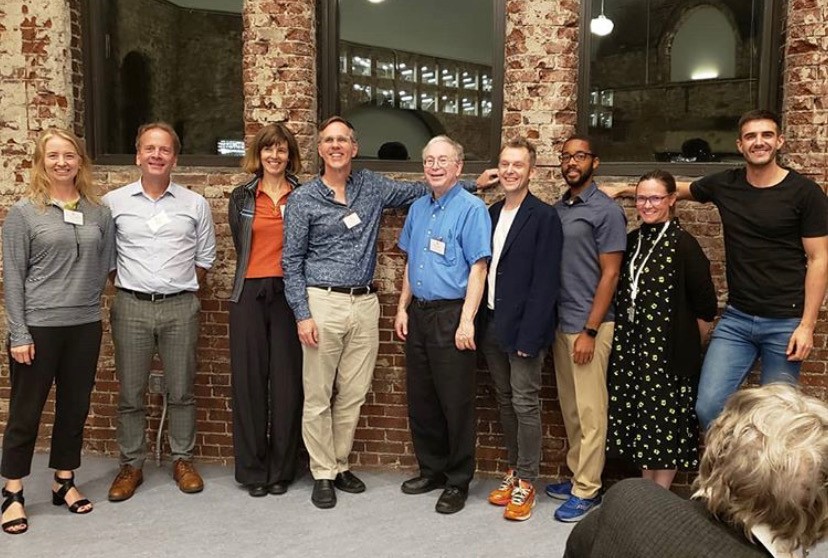One thing that has been on my mind lately (for a long time actually) is the concept of time in online classes. (Filing this under the umbrella of thoughts inspired by Critical Digital Pedagogy (Morris & Stommel), An Urgency of Teachers, #digped and #femedtech discussions.) We often sell online courses/programs as convenient, they can “fit in your schedule,” “anytime anywhere.” Those of us who have been online learners know…that’s simply not the case, it’s way more complicated.
I’ve been teaching online (as fixed-term/clinical faculty) since 2006 (with the Master of Art in Educational Technology program at MSU and now with the EdD program in Leadership and Innovation at ASU.) Additionally, a good portion of my own MA coursework (at MSU) was online. So, I’m creeping up on 20 years of being an online learner. With experience comes some comfort – and an understanding of what time means online, especially in a course management system (CMS).
Most of the tools in CMSs that relate to time are surveillance oriented: how long did you spend in the course, how long did you spend on a specific page, when did you submit the assignment, how much of the video did you watch? As if seeing a statistic that a student “only” spent 15 minutes in the course means that they didn’t engage (when, in fact, they could have downloaded all of the materials and worked outside of the CMS.)
I don’t completely ignore the stats – if I see one of my students hasn’t logged in or engaged, that’s a cue to me to check in on them to see if they’re ok, if there is any way I can help. When you teach online, you develop a sixth sense for the “vibe” of your class. If I’m engaged, the students are also engaged. I don’t have “late penalties” (even though the CMS forces a submission deadline) – if it’s submitted at 1am instead of 11:59pm it’s most likely because my student has been working all day, taking care of their family, and has budgeted midnight to 3 am to do coursework. This is scenario that I want to talk about – and provide some scaffolding around for my students.
Graduate coursework takes time – time you’re giving to yourself. Time to engage in ideas, time to read, time to write. When we’re bounded in 3 hour blocks, or all-day weekend classes in on-campus courses, it’s easy (for the most part) to block out distractions. When we try to block that time at home or at work…not so easy.
As online instructors (and you might even be able to argue any mode of learning), I think we need to be more up front about time – and our expectations for time. Most universities have provided some scaffolding around this (which is usually hidden in academic procedures manuals, which, I like to read!) Generally, for a 3-credit graduate course, you are expected to dedicate about 9 hours of work. I honestly have no idea how universities came up with this metric, but the idea is that you spend 3 hours “in-class” and 6 hours of “homework.” So, I use that as a general rule. If students are new to online learning, how are they expected to know how much, or even how, to dedicate time in the online classroom space – which, isn’t always (especially in my class) in a CMS.
Here are two ways I make time open to students:
Example 1: Module Overview
This is an example of the text/format I use for TEL 713: Advanced Qualitative Methods.
A Note on Time on Task
This course is 3 graduate credits. For 3 graduate credits, you should expect to dedicate 9 hours per week to the course. In designing the course, we have worked very hard to make sure that expectations fall within the 9 hours. At the end of every module overview, you will see a section called TIME ON TASK* with suggested time frames for each activity. These expectations are provided in the spirit of openness and transparency – and are simply that, guidelines. If you complete some tasks faster, that is ok. If you’re finding you are spending well over the time suggested, please contact the instructor.
These are general guidelines, however, especially as you start to work on concepts which directly apply to your dissertation, you may find yourself in what Csikszentmihalyi defines as flow. You certainly should not worry about going over the time allotted you find yourself in this state!
Module Assignments & Time On Task
Listen to instructor video & read overview – 30 minutes
-
- Readings – 3 hours
- Connect (this includes posting your VoiceThread and & listening) – 1 hour
- Question (post to discussion forum) – 30 minutes
- Play (set up notebook and write first entry) – 2 hours
- Apply (set up document and start assignment) – 2 hours
Example 2: Spreadsheet
This is an example of the text/spreadsheet I use for TEL 703 Innovation in Teaching and Learning, TEL 711 Strategies for Inquiry, and TEL 707 Reading the Research. This is a cluster of courses that students take simultaneously over 15 weeks. (I teach 2 of the 3 courses, but, we work as a team to deliver the experience.)
This is a “time on task*” spreadsheet that many students found helpful last semester. Many students find the transition to three 3-credit courses a bit overwhelming. This spreadsheet helps to give an idea of how to break your work up across the weekly modules. Please do not see the suggested times as “set in stone” – everyone works at a different pace. But, if you do find yourself going well over the suggested times, please reach out to us as your instructors to help provide strategies for managing your workload (click image to enlarge):

—
Now, I know it may seem silly to articulate time down to the minute, but, those are only provided as general guidelines..simply a place to start…an initial point of reference until you find your own pace.
I’m also up front with the time I dedicate to feedback. It’s ideal that assignments/posts/blogs/artifacts are submitted when requested, because, I turn those back within 24-48 hours. You email me, I email you back, generally in less than 12 hours – never more than 24. If something is marked urgent (which I tell my students to do if they need an ASAP answer) and if it’s within (my) waking hours, you get a response ASAP. This is the hardest part of the “anytime anywhere” – it’s anytime anywhere for the learner…which to me is a twisted perspective that the instructor/guide is absent in an online environment. We mediate just as much as the content on the screen mediates. In a class I can read your face, I can see the struggle…I can’t see that online. BUT if I give you some guidelines, and open the door wide open to ask for help – at that moment you’re feeling the struggle…I hope I can catch you before you start spinning wheels and getting angry, sad, frustrated, defeated, second guessing…all things that happen way to easily in asynchronous spaces.
Now, the paragraph above is tricky as well – I do have to be diligent myself with turning things off, something I’ve gotten much better at doing. (I used to get up at 3am to answer emails. I no longer do this.) Because I’m open with my time (and when my time is open), I have found that students respect and understand these boundaries and know when I’m “on” and if an urgent response is needed – they email me during those times.
So…this is my first attempt at articulating this in the open. I would love to hear your strategies for dealing with time. Would also love to hear criticisms or critiques of my lines of thinking.
*The naming of this as “time on task” was very intentional. A standard question on instructor evaluation forms often reads “Instructors emphasize time on task”…what does that mean?! I’m not 100% sure (and neither are the students based upon their comments) but, we’re evaluated on it nonetheless.
 I’m delighted to announce that the special issue of Special Issue of UTE. Universitas Tarraconensis: Revista de Ciències de l’Educació that I co-edited along with the amazing Linda Castañeda, has been published! The special issue is titled: Educational Technology in Higher Education: Emergent Practices for Teaching Future Educators.
I’m delighted to announce that the special issue of Special Issue of UTE. Universitas Tarraconensis: Revista de Ciències de l’Educació that I co-edited along with the amazing Linda Castañeda, has been published! The special issue is titled: Educational Technology in Higher Education: Emergent Practices for Teaching Future Educators.
 In the fall of 2019 I was asked to serve as a faculty advisor for Current Issues in Education (along side my incredible colleague Dr.
In the fall of 2019 I was asked to serve as a faculty advisor for Current Issues in Education (along side my incredible colleague Dr. 



